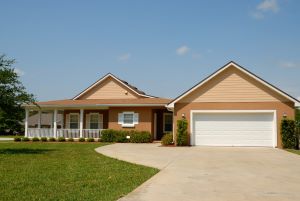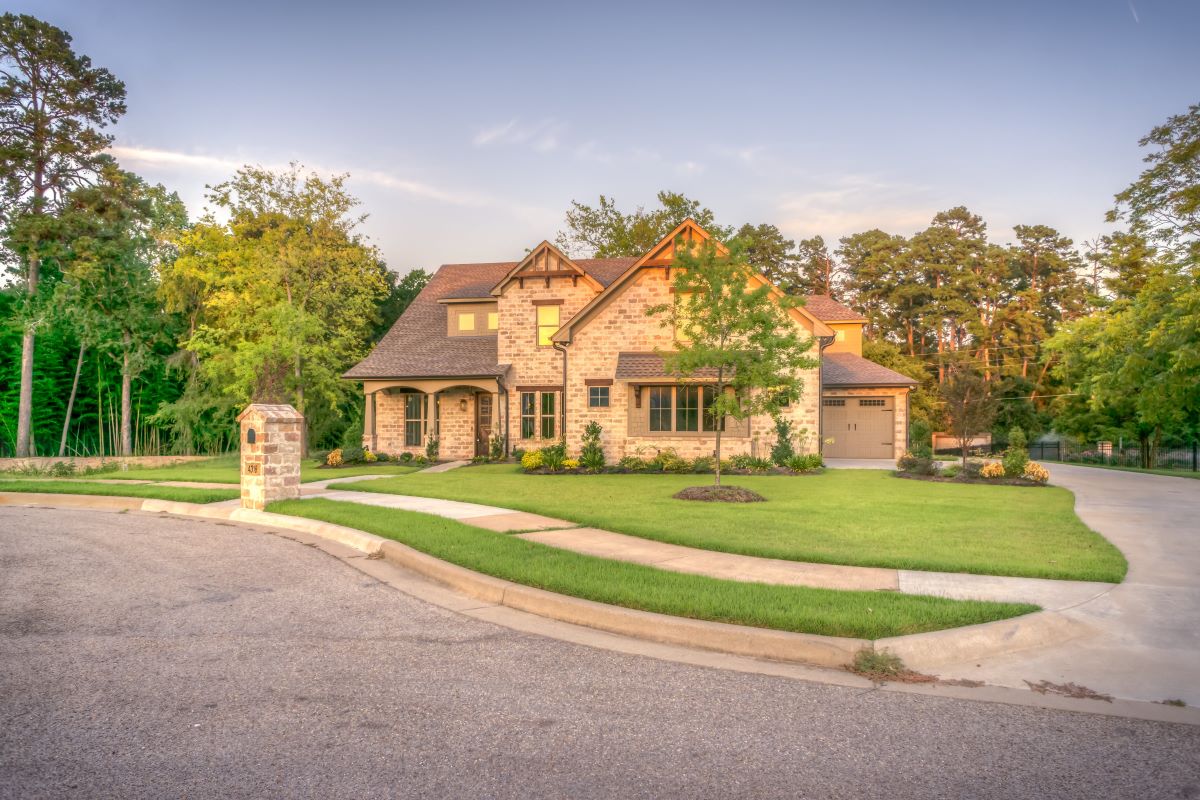Transforming your lawn into a picture-perfect oasis doesn’t have to be a daunting task. An essential part of this transformation is an often overlooked landscaping element – lawn edging. Serving both functional and aesthetic purposes, lawn edging not only delineates your garden areas but also prevents the encroachment of grass into your flower beds. It comes in a variety of materials, ranging from natural stone, wood, and plants, to synthetic options such as plastic, concrete, and metal. Whether you prefer a DIY project or choose to hire professionals, understanding lawn edging is crucial in maintaining the beauty and health of your landscape so you can revamp your yard.
Understanding Lawn Edging
The Fundamentals of Lawn Edging
Lawn edging serves as a clear demarcation between different areas in your garden, aiding the maintenance of a tidy and well-structured landscape. The basic function is to split up various sections of your yard like your lawn, flower beds, pathway, or vegetable garden. It acts as a boundary, thereby preventing undesired growth of grass and weeds into flower beds or pathways, contributing significantly to the neat appearance of your lawn.
Functionality and Aesthetics
Lawn edging functions both as a decorative and practical element in a landscape design. The broad range and styles of edging options can complement a diverse array of garden designs, therefore, careful selection helps integrate the edging seamlessly into the overall aesthetic of your lawn while also serving practical needs.
Preventing the Spread of Grass and Weeds
Without a defining border or lawn edging, your grass can steadily encroach into flower beds and beyond, thus spoiling the overall appeal of your landscape. However, with an effective lawn edging system, the spread of grass and weeds into flower beds can be controlled. An edging acts like a barrier, thus managing to contain thick grass, vigorous weeds, and other invasive plants.

Diverse Lawn Edging Ideas
Fancy Brick Edging is an excellent option if one desires to give an old-world charm to the garden. The bricks can be angled at 45 degrees to create a deep edge that grass runners won’t traverse.
For a more natural feel, woven Willow Edging can be used. Here the willows can be woven together to make a beautiful edging for flower beds.
The Stone Edging option offers a rustic charm if that fits your garden’s style. These rough stones stacked together form an interesting edging which is both functional and aesthetically pleasing.
Plastic or Metal Edging, though they might not be as visually pleasing, are strong, durable, and easy to install, making them functional choices.
Recycled items such as glass bottles can be used to create a unique and environmentally-friendly border, providing the garden a splash of color.
Consider the fact that your selection of lawn edging significantly influences your garden’s overall aesthetic and functionality. Don’t make a hasty decision. Instead, think about both the practical and stylistic effects different types of lawn edging will have on your garden’s landscape.
Types of Lawn Edging Materials
Using Natural Materials for Lawn Edging
If you’re browsing natural materials for lawn edging, stone is a choice favored by many. Stones, with their variety in color, shape, and size, can be employed subtly with flat ones or used dramatically with larger boulders. While stone edging can lean on the pricier side—particularly if you choose larger or unique stones—their resilience and timeless appeal make them a worthwhile investment. They can withstand various weather conditions, rendering their natural beauty intact over the years.
Wood is another popular option for those leaning towards natural lawn edging material. Whether you opt for logs, treated lumber, or planks, each offers its unique charm, and the rustic appeal they bring pairs superbly with cottage or woodland gardens. A cedar edging is a notable choice because of its intrinsic decay-resistance. However, it’s essential to remember that even pressure-treated wood might lose the test of time, being susceptible to rot and warping after about a decade.
Should you fancy a softer, more organic look, you could consider plant borders for your lawn edging. Certain plants, particularly ground covers and short perennials, make excellent borders. For instance, hostas and daylilies have dense foliage that restricts weed growth, while lavender and rosemary add a refreshing aroma to your garden. You need to maintain and routinely trim them, but these plant borders add a pop of color and texture variety to your garden, enhancing its appeal.
Exploring Synthetic Lawn Edging Materials
If you’re after an economical choice for edging your lawn, synthetic materials such as plastic are your best bet. Favored by many DIY garden enthusiasts for its lightweight and easy-to-install properties, plastic edging comes in handy rolls that can be trimmed to suit a variety of lengths. However, keep in mind that plastic edging can turn brittle and tend to crack over time, especially under colder climates.
As a more durable synthetic alternative, consider using concrete. Its strength and design flexibility are great qualities, and the availability of preformed blocks specifically for lawn edging makes it a convenient option. With a plethora of styles and colors, they’re sturdy and built to last, albeit somewhat pricier than other alternatives.
Another fantastic choice for lawn edging is metal, particularly steel or aluminum. Excellent for retaining straight lines and tight curves, these are perfect for maintaining the aesthetics of a formal garden. While metal may be a notch above plastic in terms of cost, the risk of cracking or warping is significantly reduced. Aluminum, in particular, is resistant to rust and is generally more enduring than steel, given it is thick enough.
To sum it up, your choice between natural or synthetic materials for lawn edging will be determined by your budget, garden style, and the amount of maintenance you’re open to doing. Every material comes with its own unique set of pros, cons, and aesthetic appeal. It’s essential to remember that lawn edging isn’t merely practical—it plays a pivotal role in defining your garden’s overall look and feel.

DIY Lawn Edging Ideas
Understanding the Process of DIY Brick Edging
A creative and durable way to edge your lawn is by using bricks. Known for their varied colors, styles, and tough resistance to the elements, brick edging can really elevate your lawn’s aesthetics. To use brick edging, start by carving out a trench around your lawn, about 6-8 inches deep. Now, arrange the bricks along the trench – you can lay them flat, either lengthwise or crosswise in the trench. You even have the option of setting them at alternate angles for a distinctive appeal. To ensure the bricks remain stable, fill in the gaps around and beneath the bricks with soil.
Concrete Lawn Edging
Concrete lawn edging boasts durability, minimal maintenance, and is perfect for curvilinear landscapes. Begin by laying out your desired edging design using a garden hose. Once satisfied, mark out your border with landscaping paint. Up next, load mixed concrete into a concrete edger to produce defined concrete blocks or a continuous edging design, based on your preference. Be sure to smooth out the concrete edges with a trowel for a neat finish.
Wooden Lawn Edging
Creating wooden lawn edging requires untreated wood for your borders. Cedar and redwood are recommended due to their resistance to rot and pests. Cut your wood into desired lengths and treat it with a waterproof sealant. Dig a trench along the lawn’s edge and place the wooden pieces into the trench. Ensure that they’re level, and the tops are flush with the ground. Backfill with soil, leaving an inch of wood above the ground to deter pests.
Metal Lawn Edging Bands
Metal lawn edging delivers contemporary styling and strong separation. There’s a range of metals to choose from including aluminum, steel, and iron. To install, pound the metal edging into the ground using a rubber mallet, ensuring the edge of the metal aligns with the ground level. Be cautious of sharp metal edging corners and protect them using steel plugs or edging covers.
Stone Borders
These exude a natural, rustic charm and can be easily incorporated into most garden themes. You can choose from a wide variety of stones such as flagstone, cobblestone, or fieldstone. Place stones in a trench along the edges of your lawn in an arrangement of your choice. Filling gaps with soil or smaller stones gives a compact look.
Recycled Items
For those looking to be creative while environmentally conscious, recycled items can be an innovative addition to lawn edging. Old bottles, bowling balls, or even broken terracotta pots can be arranged to create a distinctive border. Consider burying them halfway into the ground to maintain stability, while creating a visually striking detail.
Living Lawn Edging
For a different take, lawn edging can be brought to life by planting your borders with low-growing flowers, perennial shrubs, or herbs. This approach can be particularly effective in defining different areas of your yard while adding an extra dash of color and texture.
In every lawn edging idea that you pursue, ensure to excavate a trench deep and wide enough to fit your chosen edging material. Additionally, try to align the top edges of the materials for a neat, polished, and cohesive appearance.
Professional Lawn Edging Services
Engaging Professionals for Your Lawn Edging Needs
The allure and desirability of any environment, residential or commercial, are highly influenced by the elegance and condition of its outdoor spaces. The role of well-kept lawns and gardens in livening the visual appeal of a location is not to be underplayed. Among the various aspects contributing to a pristine lawn, carefully executed lawn edging stands vital.
Essentially, lawn edging is the process of creating clear, distinct boundaries separating the lawn from other parts of the landscape, such as flower beds, walkways, or driveways. Apart from bestowing a streamlined and professional look to your garden area, it holds practical applications too – containing the spread of grass to unwanted zones. Considering the high level of detail, accuracy, and precision this task demands, many individuals prefer engaging professionals to do the job.
Factors to Consider When Hiring Lawn Edging Services
There are three primary factors to consider when hiring lawn edging services: experience, quality of work, and price. The longevity of the service provider in the business often serves as a proxy for their experience. Verify this by asking for proof or references.
Quality of work is the most critical factor, heavily influencing the overall aesthetic of the property. To evaluate this, ask for a portfolio of previous work or even visit their past projects. Proceed with those whose aesthetics match your own. Additionally, verify if they have any industry certifications or use professional-grade equipment.
Price can be subjective and varies dramatically based on the size of the lawn and intricacy of the work. However, it’s important to ensure that you obtain value for your money. Shop around, obtain quotes from multiple providers, and compare them before finalizing.

Typical Costs Involved
Professional lawn edging services typically charge by the hour or offer a flat rate for the entire project. The cost depends on many factors, including the type and materials of edging used, complexity of the layout, and the area to be edged. On average, these services can range anywhere from $50 to $100 per hour. Flat rates might start from $200 for a simple project and can exceed $1000 for larger or more detailed lawns.
Selecting a Reputable Service Provider
A step often overlooked but vital is to ensure that your chosen provider is reputable. Look for customer reviews and ratings online or ask the business directly for references. Confirm the provider is licensed and insured to protect yourself financially should an accident or property damage occur.
When negotiating the contract, carefully go over their policies on yard cleanup and waste disposal. Also, verify that their schedule aligns with yours. Lastly, ensure a warranty or guarantee is provided for the work completed to safeguard your investment and assure quality work.
In essence, deciding to partner with a seasoned professional for your lawn edging needs can dramatically elevate the aesthetic appeal of your yard. Not only does it present a distinct and beautiful landscape, but by consciously evaluating aspects such as expertise, workmanship, and pricing, while choosing a trusted service provider, you ensure that your lawn makeover project is both successful and visually appealing.
Maintaining Your Lawn Edging
Different Lawn Edging Types and Their Maintenance
There are innumerable lawn edging styles that can amplify the beauty of your garden, each possessing its distinct attributes and care routines. Brick edging, for instance, marries well with a more conventional architectural style, providing a vintage charm. To retain its allure, bricks need to be kept spotless, rid of moss, and devoid of weeds. A sturdy brush works well for the cleaning and for trickier dirt stains, a pressure washer could be employed.
Stone edging lends an equally traditional yet versatile look, and can oscillate between rugged, irregularly-shaped stones and polished, geometric shapes. In order to preserve its aesthetic, frequent washing and vigilance for any displaced or sinking stones is necessary.
For those who prefer a contemporary appearance, metal edging such as steel or aluminum can offer a polished, modern vibe. However, rust can compromise its look, so routine checks for rust spots and timely application of suitable paint or sealant are recommended.
Plastic or resin edging, owing to its high versatility and myriad color and style options, is a popular choice. However, it tends to fade over time. Regular cleansing and periodic repainting could help retain its vivid and pristine condition.
Regular Upkeep and Replacement of Lawn Edging
Generally, lawn edging requires regular upkeep to remain visually appealing and functional. Keep a check on any signs of damage or wear like chipping, fading, or breakage. In the case of substantial damage, it may be wise to consider replacement.
Accumulation of dirt and debris is another common problem with lawn edging. Regular cleaning with water and suitable cleansers prevents buildup and maintains the edging’s beauty. For systemic issues like sinking or shifting, reinstatement or complete replacement could be necessary.
Problem-Solving for Lawn Edging
Aside from regular maintenance and replacement, problem-solving is crucial for sustaining the longevity of lawn edging. For instance, when dealing with weed growth between bricks or stones, utilizing landscape fabric beneath can suppress weed growth.
In the case of fading plastic or resin edging, instead of complete replacement, you might consider a fresh coat of outdoor plastic paint. If edging pulls away from the lawn or sinks down, refilling with topsoil or resetting the edging may resolve the issue.
Retaining the functionality and appeal of lawn edging
involves both routine maintenance and proactive problem-solving. No edging option is entirely maintenance-free, but with basic care and attention, it can significantly enhance lawn aesthetics and functionality for many years.
Whether you’ve chosen natural, synthetic materials, embarked on a DIY project, or enlisted professional help, the journey towards an aesthetically pleasing lawn doesn’t end with installation. Regular upkeep, timely replacement, and adept problem-solving are key to keeping your lawn edging intact and attractive. Moreover, the perfect type of lawn edging not only complements your home’s architectural style but also acts as a protective barrier for other elements of your landscape. Learning about the wide range of lawn edging possibilities and understanding how to maintain them effectively can indeed prove rewarding in your landscaping endeavors.

